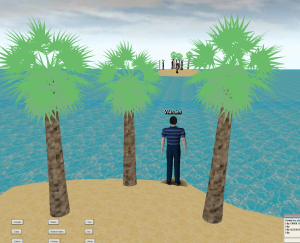Today’s guest blogger is Clyde Warren. Clyde is a Professor of Chinese Consumer Behavior at the University of Stirling (Singapore) Institute for Retail Studies and at the National Chung Hsing University (in Taiwan). Recently, Clyde implemented an Open Wonderland project for a business class in Taiwan which he talks about below. Clyde may be reached at: clydewarden@gmail.com.
How real does a virtual environment need to be for users to feel presence? This is a question educators have been researching in the attempt to implement virtual spaces to expand the classroom. For those of us old enough to have been playing eight bit video games and text-driven adventures, we already have a good feeling for the answer—not much reality is required. Quantifying this answer has been my research topic over the last couple years, and Open Wonderland is open road, making it possible to perform structured experimental designs educators and researchers will find most useful.
Two takeaway points:
- Open Wonderland’s freedom (as in free speech) allows, and even encourages, users to create worlds and tools that match exactly what is needed (in my case, a controlled experiment that incorporates existing teaching materials).
- Open Wonderland allows the implementation of nearly any metaphor that can reinforce underlying goals and teaching points, and those metaphors, even if somewhat abstract, raise feelings of presence among participants.
In Taiwan, where I have been an expatriate for a couple decades, my business negotiation class was the focus for an experiment using OWL. Over the past five years, I developed a pen and paper negotiation Role Playing Game (RPG) where groups of students bought and sold simulated products, negotiating details of price, quality, shipping, etc. One big problem was trying to simulate negotiations in a tiny classroom, where getting any privacy was impossible. OWL overcame this problem through virtual space, which I then used to test feelings of presence.
I measured feelings of presence among students in two different virtual environments—one high abstraction and one low abstraction. Rather than produce a realistic environment, the goal was to test a metaphorical environment. For my negotiation class, a key concept is the importance of the negotiation team, keeping core information secret, planning goals, and distributing work, while having access to members of other teams. For my class, I implemented an island metaphor, within OWL, with each team owning its own island and class lectures held in a central classroom location. This became the low abstraction environment in the experiment. If this setting produced a measurable feeling of presence, the benefit would include those feelings as well as the opportunity to use a metaphor in teaching. This setting was compared to a fully abstract environment, where students negotiated and lectures were held in an empty space that only included teaching materials, such as slides.
Low-level abstract virtual space adopted an island metaphor:
Research results showed students had statistically higher feelings of presence in the island metaphor world compared with the totally abstract world. The RPG paper game was executed, but now with students negotiating inside OWL, alternating between the two environments (low and high abstraction). Even with a small sample size (low statistical power), results were strong. While a difference between an empty world and a non-empty world may be obvious, the important finding is that a metaphor-based world can generate feelings of presence, avoiding the need for a high fidelity simulation. Rather than having offices, desks, and chairs, the island metaphor gave students a lasting picture of a key negotiation concept that they will remember.
High abstract virtual space:
The details of this work were published in the highly ranked research journal Computers & Education (Level of abstraction and feelings of presence in virtual space: Business English negotiation in Open Wonderland, Volume 57, pp. 2126-2134).
To learn more, visit http://cwarden.org/.








 Posted by elizabethskim
Posted by elizabethskim